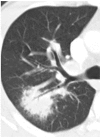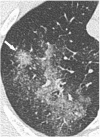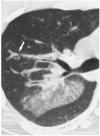Typical and atypical manifestations of intrathoracic sarcoidosis
- PMID: 19885319
- PMCID: PMC2770817
- DOI: 10.3348/kjr.2009.10.6.623
Typical and atypical manifestations of intrathoracic sarcoidosis
Abstract
Sarcoidosis is a systemic disorder of unknown cause that is characterized by the presence of noncaseating granulomas. The radiological findings associated with sarcoidosis have been well described. The findings include symmetric, bilateral hilar and paratracheal lymphadenopathy, with or without concomitant parenchymal abnormalities (multiple small nodules in a peribronchovascular distribution along with irregular thickening of the interstitium). However, in 25% to 30% of cases, the radiological findings are atypical and unfamiliar to most radiologists, which cause difficulty for making a correct diagnosis. Many atypical forms of intrathoracic sarcoidosis have been described sporadically. We have collected cases with unusual radiological findings associated with pulmonary sarcoidosis (unilateral or asymmetric lymphadenopathy, necrosis or cavitation, large opacity, ground glass opacity, an airway abnormality and pleural involvement) and describe the typical forms of the disorder as well. The understanding of a wide range of the radiological manifestations of sarcoidosis will be very helpful for making a proper diagnosis.
Keywords: Computed tomography (CT); Sarcoidosis; Thorax.
Figures
















Comment in
-
The reversed halo sign: another atypical manifestation of sarcoidosis.Korean J Radiol. 2010 Mar-Apr;11(2):251-2. doi: 10.3348/kjr.2010.11.2.251. Epub 2010 Feb 22. Korean J Radiol. 2010. PMID: 20191076 Free PMC article. No abstract available.
References
-
- Colby TV, Carrington CB. Infiltrative lung disease. In: Thurlbeck WM, editor. Pathology of the lung. Stuttgart: Thieme Medical; 1988. pp. 425–517.
-
- Müller NL, Kullnig P, Miller RR. The CT findings of pulmonary sarcoidosis: analysis of 25 patients. AJR Am J Roentgenol. 1989;152:1179–1182. - PubMed
-
- Koyama T, Ueda H, Togashi K, Umeoka S, Kataoka M, Nagai S. Radiologic manifestations of sarcoidosis in various organs. Radiographics. 2004;24:87–104. - PubMed
-
- Hamper UM, Fishman EK, Khouri NF, Johns CJ, Wang KP, Siegelman SS. Typical and atypical CT manifestations of pulmonary sarcoidosis. J Comput Assist Tomogr. 1986;10:928–936. - PubMed
-
- Rockoff SD, Rohatgi PK. Unusual manifestations of thoracic sarcoidosis. AJR Am J Roentgenol. 1985;144:513–528. - PubMed

